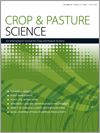CP18273Molecular characterisation of the NAM-1 genes in bread wheat in Australia
The finding from this study can be used in wheat nitrogen use efficiency based on the different NAM gene allelic composition. In addition, molecular makers for the NAM genes will be developed for wheat breeding program.





